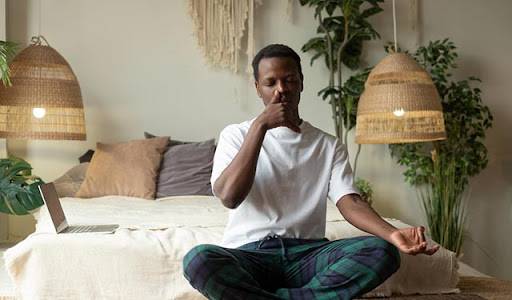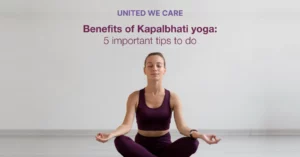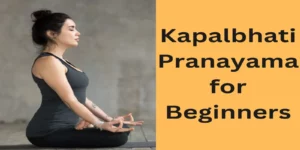Pranayama is an ancient technique that has been practised for centuries to improve one’s health and well-being. This practice involves controlled breathing, which purifies the body and mind. Researchers associate numerous benefits with pranayama, including improved blood circulation, increased energy levels, reduced stress, and improved mental clarity. This article will help you learn about a specialised pranayama technique known as Dirga pranayama.
What is Dirga Pranayama?
“Dirga” in Sanskrit means slow, deep, and complete. Dirga pranayama, also known as three-part breath or full breath, is a yogic breathing exercise that benefits both the body and the mind. This particular pranayama technique involves inhaling deeply into the three parts of the body – the belly, lower chest, and then finally the upper chest. Once the lungs are complete, the breath is released slowly and evenly through all three areas. This yoga asana is taught to beginners to learn how to channel air through the different parts of the body.
Dirga pranayama is said to help improve lung function, increase oxygen intake, and reduce stress and anxiety. Additionally, this type of breathing exercise can also help to improve digestion and elimination. If you are looking to improve your overall health and well-being, consider adding Dirga Pranayama to your daily routine.
Our Wellness Programs
The Benefits of Dirga Pranayama
Yogic literature repeatedly mentions correct breathing techniques. It believes that the wrong breathing technique is the root cause of almost all health concerns. We have forgotten to practice deep, mindful breathing in today’s fast-paced life. Unknowingly, we all take shallow breaths, involving only the upper chest. It leads to inadequate oxygenation and puts stress on the lungs and heart.
Dirga Pranayama teaches us the deep breathing technique, which increases oxygen levels in the blood and rejuvenates and energises the whole body. Studies show that when you practice Dirga Pranayama, your body fills up with seven times more air than in one cycle of shallow breathing.
Dirga Pranayama relaxes your mind and increases your focus, laying the foundation for a meaningful meditation.
Some benefits associated with Dirga Pranayama include:
- Increased oxygen intake
- Improved lung function
- Reduced stress and anxiety
- Improved digestion and elimination
- Stronger immune system
- Improved sleep quality
Looking for services related to this subject? Get in touch with these experts today!!
Experts

Banani Das Dhar

India
Wellness Expert
Experience: 7 years

Devika Gupta

India
Wellness Expert
Experience: 4 years

Trupti Rakesh valotia

India
Wellness Expert
Experience: 3 years
The History of Dirga Pranayama
Mention of Pranayama has been found in Bhagwad Gita and Yoga Sutras of Patanjali. Pranayama is believed to have been practised since the 6th and 5th Centuries BC, with the origin of yoga. Dirga Pranayama is an ancient yogic breathing exercise that has been used for centuries. This particular technique originates from the Hatha Yoga Pradipika, a text written over 500 years ago. This text describes Dirga pranayama as a way to purify the body and mind and provide numerous other benefits. Today, people practise Dirga Pranayama worldwide to de-stress and rejuvenate themselves from the life force.
How to practice Dirga Pranayama?
- To start with, sit in Sukhasana or lie down in Savasana pose. If you lie down, keep your eyes closed and relax your body and face. You may bend your knees or keep your legs outstretched.
- Watch your breath as it naturally inhales and exhales while keeping a calm mind.
- Start inhaling and exhaling deeply through your nose.
- Inhale deeply and let the air fill your belly as much as possible.
- Now, exhale smoothly and expel all the air from the belly. Draw in your navel towards the spine as much as you can. It is the first part of Dirga Pranayama.
- Repeat it about five times.
- With the next inhalation, let the air fill the belly, inhale some more and let the air into your rib cage. Feel the rib cage expanding.
- Exhale, letting the air out first from the rib cage, feeling it closing down, and then from the belly, drawing in the navel again towards the spine.
- It is step two of the three-part breath. Repeat this step 5 times.
- Inhale and fill your belly and rib cage as above for the third and final step. Now, take in some more breath and let it pass up into your upper chest, up to the collarbone, and let the region around your heart expand.
- While exhaling, start expelling the air first from the upper chest, exhaling from the rib cage, and finally expelling air from the belly.
- Do this three-part breathing at your own comfortable pace.
Read more about Exercise belly fat
Tips for practicing Dirga Pranayama
Here are a few tips to help you get the most out of your Dirga Pranayama practice:
- Practice in a comfortable position and a quiet environment where you will not be disturbed.
- Practice Dirga Pranayama in a well-ventilated area.
- Breathe through your nose during this exercise. It will help filter the air and warm it up before entering your lungs.
- When you are inhaling, allow your shoulders to rise slightly. As you exhale, relax your shoulders.
- Focus on your breath throughout the exercise, and be aware of each inhale and exhale.
- Aim to practice Dirga Pranayama at least once per day. The more you practice, the more benefits you will experience.
The Risks associated with practising Dirga Pranayama
There are no known risks associated with Dirga Pranayama. However, as with any breathing exercise, there are a few things to keep in mind to avoid any health problems:
- If you have any respiratory issues, such as asthma, it is best to consult with your doctor before practising Dirga Pranayama.
- If you experience any pain or discomfort during the exercise, stop immediately and consult with your doctor.
- If it is uncomfortable, do not force yourself to breathe deeply. Instead, focus on breathing slowly and evenly.
- If you are pregnant, it is best to consult with your doctor before practising Dirga Pranayama.
Conclusion
Dirga Pranayama is one of the most relaxing and rejuvenating breathing exercises. With this complete breath technique, fill your mind and body with the vital life force and shake off all day’s worries. Practice it regularly and reap the benefits of enhanced oxygen supply to all the parts of your body, making you energetic and full of life!
Visit test.unitedwecare.com to learn about more yoga postures.


 Conflict Management in Relationships
Conflict Management in Relationships
 Healing from Heartbreak
Healing from Heartbreak Coping With Anxiety
Coping With Anxiety Get Started With Mindfulness
Get Started With Mindfulness Healing With Meditation
Healing With Meditation






